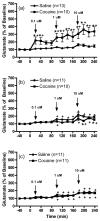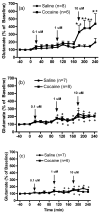Repeated exposure to cocaine alters the modulation of mesocorticolimbic glutamate transmission by medial prefrontal cortex Group II metabotropic glutamate receptors
- PMID: 18673447
- PMCID: PMC2574769
- DOI: 10.1111/j.1471-4159.2008.05593.x
Repeated exposure to cocaine alters the modulation of mesocorticolimbic glutamate transmission by medial prefrontal cortex Group II metabotropic glutamate receptors
Abstract
Repeated cocaine exposure enhances glutamatergic output from the medial prefrontal cortex to subcortical brain regions. Loss of inhibitory control of cortical pyramidal neurons may partly account for this augmented cortical glutamate output. Recent research indicated that repeated cocaine exposure reduced the ability of cortical Group II metabotropic glutamate receptors to modulate behavioral and neurochemical responses to cocaine. Thus, experiments described below examined whether repeated cocaine exposure alters metabotropic glutamate receptor regulation of mesocorticolimbic glutamatergic transmission using in vivo microdialysis. Infusion of the Group II metabotropic glutamate receptor antagonist LY341495 into the medial prefrontal cortex enhanced glutamate release in this region, the nucleus accumbens and the ventral tegmental area in sensitized animals, compared to controls, following short-term withdrawal but not after long-term withdrawal. Additional studies demonstrated that vesicular (K(+)-evoked) and non-vesicular (cystine-evoked) glutamate release in the medial prefrontal cortex was enhanced in sensitized animals, compared to controls, that resulted in part from a reduction in Group II metabotropic glutamate receptor modulation of these pools of glutamate. In summary, these findings indicate that the expression of sensitization to cocaine is correlated with an altered modulation of mesocorticolimbic glutamatergic transmission via reduction of Group II metabotropic glutamate receptor function.
Figures








Similar articles
-
Repeated exposure to cocaine alters medial prefrontal cortex dopamine D₂-like receptor modulation of glutamate and dopamine neurotransmission within the mesocorticolimbic system.J Neurochem. 2011 Oct;119(2):332-41. doi: 10.1111/j.1471-4159.2011.07362.x. Epub 2011 Sep 20. J Neurochem. 2011. PMID: 21692802
-
Cystine/glutamate exchange regulates metabotropic glutamate receptor presynaptic inhibition of excitatory transmission and vulnerability to cocaine seeking.J Neurosci. 2005 Jul 6;25(27):6389-93. doi: 10.1523/JNEUROSCI.1007-05.2005. J Neurosci. 2005. PMID: 16000629 Free PMC article.
-
Group I metabotropic glutamate receptors in the medial prefrontal cortex: role in mesocorticolimbic glutamate release in cocaine sensitization.Synapse. 2013 Dec;67(12):887-96. doi: 10.1002/syn.21699. Epub 2013 Aug 30. Synapse. 2013. PMID: 23913407
-
Neurotransmitter systems of the medial prefrontal cortex: potential role in sensitization to psychostimulants.Brain Res Brain Res Rev. 2003 Mar;41(2-3):203-28. doi: 10.1016/s0165-0173(02)00233-3. Brain Res Brain Res Rev. 2003. PMID: 12663081 Review.
-
Cortical mechanisms of cocaine sensitization.Crit Rev Neurobiol. 2005;17(2):69-86. doi: 10.1615/critrevneurobiol.v17.i2.20. Crit Rev Neurobiol. 2005. PMID: 16808728 Review.
Cited by
-
Examination of a role for metabotropic glutamate receptor 5 in the medial prefrontal cortex in cocaine sensitization in rats.Psychopharmacology (Berl). 2012 May;221(1):91-100. doi: 10.1007/s00213-011-2548-1. Epub 2011 Nov 16. Psychopharmacology (Berl). 2012. PMID: 22147256
-
Cocaine modulates both glutaminase gene expression and glutaminase activity in the brain of cocaine-sensitized mice.Psychopharmacology (Berl). 2012 Feb;219(4):933-44. doi: 10.1007/s00213-011-2418-x. Epub 2011 Aug 2. Psychopharmacology (Berl). 2012. PMID: 21809009
-
The mGluR2 positive allosteric modulator BINA decreases cocaine self-administration and cue-induced cocaine-seeking and counteracts cocaine-induced enhancement of brain reward function in rats.Neuropsychopharmacology. 2010 Sep;35(10):2021-36. doi: 10.1038/npp.2010.82. Epub 2010 Jun 16. Neuropsychopharmacology. 2010. PMID: 20555310 Free PMC article.
-
Blockade of Glutamate Receptors within the Prelimbic Cortex Attenuate Concentration of Excitatory Amino Acids in the Morphine Self-administration in Rats.Adv Biomed Res. 2018 Aug 29;7:116. doi: 10.4103/abr.abr_121_18. eCollection 2018. Adv Biomed Res. 2018. PMID: 30211129 Free PMC article.
-
N-acetylcysteine normalizes glutamate levels in cocaine-dependent patients: a randomized crossover magnetic resonance spectroscopy study.Neuropsychopharmacology. 2012 Aug;37(9):2143-52. doi: 10.1038/npp.2012.66. Epub 2012 May 2. Neuropsychopharmacology. 2012. PMID: 22549117 Free PMC article. Clinical Trial.
References
-
- Baker DA, Shen HW. Cystine/glutamate exchange serves as the source for extracellular glutamate: modifications by repeated cocaine administration. Amino Acids. 2002;23:161–162. - PubMed
-
- Baker DA, McFarland K, Lake RW, Shen H, Tang XC, Toda S, Kalivas PW. Neuroadaptations in cystine-glutamate exchange underlie cocaine relapse. Nature Neurosci. 2003;6:743–749. - PubMed
-
- Beyer CE, Steketee JD. Cocaine sensitization: modulation by dopamine D2 receptors in the rat medial prefrontal cortex. Cereb Cortex. 2002;12:526–535. - PubMed
MeSH terms
Substances
Grants and funding
LinkOut - more resources
Full Text Sources
Medical

